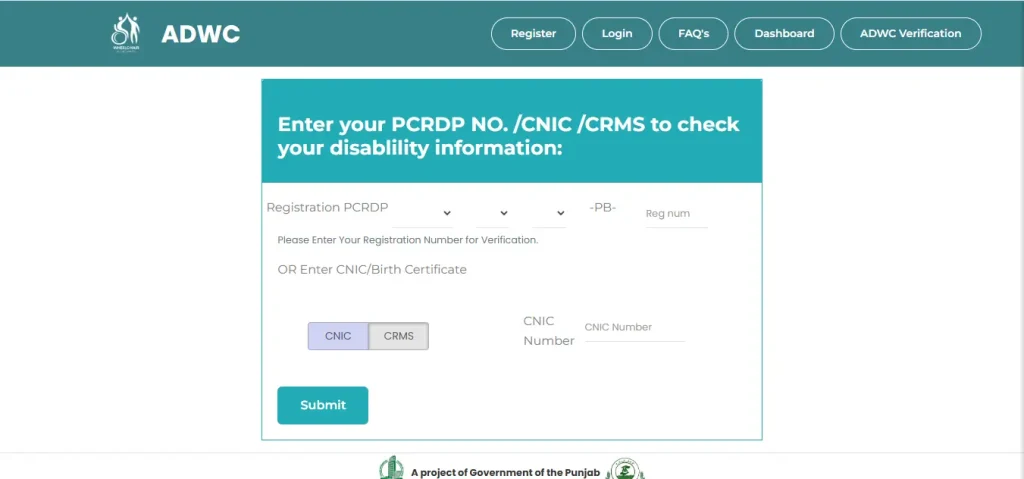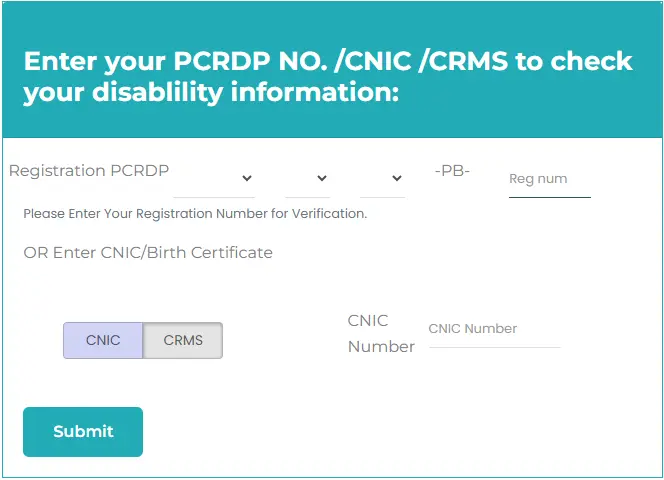Free Assistive Devices and Wheelchair Program [ADWC Registration] 2025

A massive number of disabled people in Pakistan are struggling with their lives because of the unavailability of essential devices. The Punjab Assistive Device program step forward to address this issue and distributes different sets of assistive devices among the needy people.

These devices are available for free for disabled persons, which helps them improve their lives. The community has become more inclusive for disabled people because these individuals now possess the key resources that support their daily needs.
This program has provided both in-person and digital registration methods in order to easily enroll in the program. Moreover, it also supports disabled people, such as those who are struggling with walking, by providing them with assistive technologies.
| Detail Type | Information |
|---|---|
| Program Name | Assistive Devices and Wheelchair Program |
| Available Cities | All Districts of Punjab |
| Who is Eligible? | Punjab Resident Valid CNIC/B-Form Disability Assessment Certificate NADRA Disability ID Card |
| Program Objective | Free Wheelchairs, Hearing aids, Prosthetics, for Special Persons |
| Registration Link | https://adwc.punjab.gov.pk |
| Application Deadline | Registrations are OPEN |
| Documents Required | Valid CNIC ya B-Form Disability Assessment Certificate NADRA Disability ID Card |
| Contact Info | Helpline: 1312 Nearest Social Welfare and Bait-ul-Maal Office |
| Organizer/Authority | Government of Punjab – Social Welfare Department Chief Minister: Maryam Nawaz Sharif |
Main Features of the Punjab Assistive Devices Program
The Punjab Assistive Devices and Wheelchair Program provides a different set of assistive devices that play a major role in providing essential support to disabled persons. These devices enhance living standards through their availability of essential assistance. The program distributes equal opportunities to everyone through its inclusive policy structure, making it the Government of Punjab’s all-encompassing initiative.
Free Assistive Devices
There are multiple devices available that are for free, including prosthetics, wheelchairs, manual, electric, hearing aids, and other mobility aids. The core objective of this program is to improve daily lives of disabled individuals by addressing their specific requirements.
Transportation Services
The program offers free transportation services to people with disabilities in order to facilitate their work-related, educational, and medical travel. This initiative will reduce the transportation barriers for disabled people.
Online Registration Portal
An official web portal is available for online registration, which makes the registration process much easier. In that way, all people with disabilities will have access to their required devices by using this reliable and efficient online registration portal.
Fingerprint Verification and Disability ID Cards
To make the distribution reliable, everyone’s identity will be verified via biometric verification or by Disability ID cards. In that way, the government will be able to distribute the devices equally among all of the disabled beneficiaries.
Helpline for Assistance
Everyone can talk with the administration by calling the 1312 helpline number, which will help them with the registration process of the application. That will enable the people to easily navigate the system.
Eligibility Criteria for the Punjab Assistive Devices Program
The Punjab government establishes specific qualifications that every applicant should fulfill before they can enter the Punjab Assistive Devices and Wheelchair Program. This will make sure that the aid will be given to only those who are desperately in need of it. A list of specific criteria standards is given below:
Residency Requirement
To be able to qualify for the program, every applicant must need to be a resident of Punjab. This will enable the system to have access to the people within the province for providing them with the necessary resources.
Disability Certificate
Every applicant must have an authentic Disability Certificate published by the District Disability Assessment Board. The program eligibility of the applicant is totally dependent on this certificate.

Disability ID Card
NADRA will issue a Special Identity Card for disabled beneficiaries, which is mandatory for identity verification and program eligibility as well.
Health and Fitness Standards
To use the assistive devices, every applicant must satisfy the fitness and health standards. This provides the individual with their required device which will assist him in all situations.
Life Expectancy
Every applicant must have a life expectancy of three years. This indicates that there will be a specific time period for the use of the assistive devices.
Clean Legal Record
Any of the applicants must not have been involved in any sort of criminal activities, like social misbehavior or any other criminal activities. This will make sure that the program benefits will only be available to those who are in desperate need.
How to Apply for the Punjab Assistive Devices Program
Both the in-person and online methods are available for the application process of the Punjab Assistive Devices Program. The whole process of both methods is described as follows:

Online Application Method
- Visit the Official Website: You can open the official website by typing adwc.punjab.gov.pk on your dedicated browser.
- Fill Out the Application Form: The application requires several things to be filled out, including contact details, disability information, and personal details. Checking requirements with accuracy helps prevent any delays in applications before submission.
- Upload Required Documents: There are specific documents that applicants need to attach, which are proof of residence, Disability Certificate, a passport-sized photo, and authentic CNIC. Make sure that all of the documents are uploaded properly.
- Submission: After the upload of all the documents and filling out an application form, you can then submit the application online for processing.
- Biometric Verification: After the submission of the application, applicants must need to do the biometric verification by visiting the nearest Social Welfare office in their region. This is considered the most important step in the registration process.
- Confirmation: Applicants will now be able to receive the confirmation via email or sms, in which they will get information about the next steps of the distribution schedule.
In-Person Application Method
This is considered to be an alternative to the online registration method provided by the Punjab Government. All of the steps of the registration are given below:
Visiting the District Social Welfare Office:
These District Social Welfare offices are available in every district of the Punjab, where disabled people can visit for the submission of the application.
Assistance for Registration:
The staff will help out illiterate disabled individuals in filling out the application form, who don’t know how to read or write.
Application Submission:
Every applicant will submit the form to the Social Welfare office in order to start the application process.
Biometric Verification:
Just like the online registration method, biometric verification is still mandatory for registration.
Required Documents for the Application:
The set of documents is necessary for an applicant to provide for applying in the Punjab Assistive Devices Program, which is all given below:
B-Form or CNIC:
Adults need to provide their CNIC, while minors need to provide their B-form.
Disability Certificate:
The applicants must show their disability by showing the disability certificate issued by a government hospital or a District Disability Assessment Board.
Recent Passport-sized Photograph:
For the purpose of identity verification of the applicant, a recent passport-size photo of the applicant is important.
Residence Proof:
Applicants need to confirm their addresses by providing the utility bills or rental agreement as proof.
Assistive Devices Offered Under the Program
There are different sets of assistive devices offered by the Punjab Assistive Devices Program. All of these devices are listed below:
Manual Active Use Wheelchairs
This wheelchair is a lightweight and a manual device for disabled people who can now propel themselves. Beneficiaries can easily go anywhere they want, and this ease has enhanced their mobility and independence.
Pediatric Manual Wheelchairs
Children with specific mobility impairments are the main target of this pediatric manual wheelchair. These wheelchairs play a major role in their independence by providing them comfort because of their adjustable and compact specifications.
Electric/Motorized Wheelchairs
Every person requiring this wheelchair can use it because it contains an integrated motor within its structure. That will ensure the smooth movements for the individuals with the help of the powered assistance of this wheelchair.
Hearing Aids (Digital)
This digital hearing aid device improves communication by amplifying the sound, thus helping people who are struggling due to hearing loss. In that way, it will improve the hearing abilities of the people, which will help them with their daily activities.
Prosthetics
Amputees can restore their lost functionality because of the prosthetic artificial limbs successfully designed for them. These kinds of assistive devices improve the way of living, like myoelectric prosthetics, which are actually made in accordance with the requirements of the individuals.
Mobile Toilet Chairs
Mobile Toilet chairs are designed to maintain the hygiene standards, but this will reduce the mobility of the wheelchair. The persons with difficulties in use of the standard toilets will benefit from it in use for several purposes such as toilets, bathrooms and showers.
Tricycles and Tri-Motor Cycles
The tricycles together with tri-motor cycles primarily cater to users seeking dependable movement capabilities. Suitable for those who are struggling with their long-distance walking, which will increase their level of independence.
Walking Frames/Walker
Less stable and lower in strength in comparison with the tricycles, but still, it is best for individuals who want to improve their walking posture. This will have a huge positive impact on the rehabilitation of the individuals.
Rollators
Rollators provide easy movements with their greater mobility functionality equipped with wheels. Other than the traditional walker this device provides more independence to the individual while they walk.
Knee Orthosis
This device will reduce the pain and provide stabilization to individuals who are struggling with knee impairments. That will allow the individuals to recover from the surgeries or injuries with better and improved support.
Braille Equipment
Braille equipment is equipped with tactile methods to improve the reading and writing skills of the visually impaired individuals. There are different braille devices available, including braille books, braille paper, and digital readers to understand the content. This will ultimately improve the skills of visually impaired individuals, which will provide them with independence in education.
Canes/Sticks and Crutches
Individuals with disabilities in their lower limbs can use these sticks, canes, and crutches as mobility aids. They will be able to walk with independence because of the stability provided by these devices.
Conclusion
Different devices are supposed to make the lives of disabled people better with the help of the Punjab Assistive Devices Program. Each person who faces any difficulty may have their needed device, for example, those who have hearing problems can get a hearing aid device. Society has experienced a substantial transformation because the program provides adaptive devices to people with disabilities. This program also includes free transportation services in addition to the assistive devices.
All applicants must choose between accessing their registration through either an available in-person process or an online system. Applicants can file their registration through the official website in an online method or meet in person at the District Social Welfare office.
